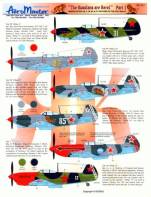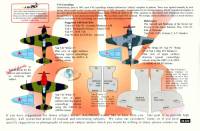Decal Sheet Review:
Aeromaster 48-622
"The Russians Are Here!" Part I
Yakovlev YAK-1B, 3, 7B, 9P &9T Fighters of the VVS 1943-47
By Roger Kelly
|
|
New from AeroMaster Products is sheet 48-222, which is the vanguard in a series
that will cover aircraft flown by the VVS in WWII. Markings are provided for six
aircraft in a variety of camouflage schemes.

- Yak-7B, flown by Senior Sergeant Pavel Petrovich Karavay, a Flight Commander
of 897 IAP, 2 AE. The markings depict the aircraft between October 1942 and
April 1943. Camouflage is AMT-6 black and AMT-4 dark green over AMT-7 underside
blue with a red spinner. Markings consist of:
- Nose art in the form of an eagle for either side of the nose
- A one-piece decal comprising a scoreboard consisting of eight red stars,
a patriotic slogan and a white bordered national insignia
- White 31 aircraft in squadron number
- Red star national insignia without a border for the fin/rudder and undersides
of the wings
- Yak-9P, flown by (now Major) Pavel Petrovich Karavay of 897 IAP in 1947.
Camouflage is overall AMT-11 grey upper surfaces, over AMT-7 blue undersurfaces
with a red spinner. Markings comprise:
- Yellow 32 plane in squadron number
- A scoreboard consisting of 16 red stars
- National insignia consisting of white bordered red stars in six places -
fuselage, fin/rudder and undersides of the wings
- Yak-7B, of Captain Ivan Ivanovich Vetrov of 65 Guards Red Banner Division,
4 GIAD, in 1944. Camouflage is AMT-11 grey-blue and AMT-12 dark grey over
AMT-7 underside blue with a red spinner and diagonal white stripes on the
fin/rudder. Markings consist of:
- A one-piece decal consisting of a tiger with a snake in its mouth over the
white plane in squadron number white 45
- The white diagonal lines for the fin/rudder
- National insignia in six places as per the above option but with a different
style fin/rudder marking

- Yak-7T, of Major Ivan Ivanovitch Vetrov of 66 Guards Red Banner Division,
4 GIAD, in 1944-45. Camouflage is AMT-11 grey-blue and AMT-12 dark grey over
AMT-7 underside blue with a red spinner and diagonal white stripes on the
fin/rudder. Markings consist of:
- Artwork consisting of a lion for the port side of the fuselage
- A scoreboard consisting of eight yellow stars
- White 85 plane in squadron numbers
- The white diagonal lines for the fin/rudder
- National insignia in six places as per the above option but with another
different style and smaller fin/rudder marking
- Yak-3, of Major B.P. Baranov, the Deputy Commander of 4 GIAD at Perlegberg
aerodrome, Germany during the summer of 1947. Camouflage is AMT-11 grey-blue
and AMT-12 dark grey over AMT-7 underside blue with a red spinner and forward
fuselage as well as red diagonal stripes on the fin/rudder and a white bordered
and darker red arrow on the nose. Markings consist of:
- Artwork consisting of a white bird superimposed over a blue sky/sea circle
with a thin red boarder for both sides of the fuselage
- The red diagonal stripes for the fin/rudder
- National insignia in six places as per the above option but with yet another
different style fin/rudder marking
- The white bordered arrow for the nose. This decal is supplied in two parts
to ease placement
- The white outlines to the red nose/forward fuselage. AeroMaster have come
to your aid here and provided templates on the rear of the placement guide
to enable you to get the demarcation between the camouflage finish and the
red so that the white border decal fits

- Yak-1B, of Senior Lieutenant A.A. Golovin, 65 Guards Red Banner Division,
4 GIAD during the Orel-Kursk operations in the summer of 1943. Camouflage
is AMT-6 black and AMT-6 dark green upper surfaces over AMT-7 underside blue
lower surfaces with the entire nose/forward fuselage and spinner in red and
white diagonal stripes on the fin/rudder. The rear of the placement guide
provides templates for painting/masking this nose of this machine as well.
Markings consist of:
- White 13 plane in squadron numbers for the fuselage
- The white diagonal stripes for the fin/rudder
- National insignia in six places. This time these markings are plain red
stars without borders· .
The decals have been printed by Cartograf, and there are sufficient markings
provided on the sheet to build each and every option.
The placement guide is in the form of AeroMaster's normal A-4 size sheet with
colour side profiles of each option and appropriate top views to show the camouflage
pattern. There is short note on VVS camouflage and paint shades that advises
you that, prior to 1943, most of the VVS camouflage schemes followed no 'official'
templates or pattens, and that each aircraft manufacturing factory evolved its
own style. Post 1943 the industry was regulated and followed basic 'rules' but
variations were widespread. I guess that this is sound advice and AeroMaster's
way of telling you to check your references before you subject your latest masterpiece
to the airbrush! The placement sheet and the decal sheet are packed in a clear
plastic zip-loc bag.
The suggested kits are the Accurate Miniatures Yak-1B, the Eduard Yak-3 'Normandie-Nieman',
the ICM Yak-9T, and the Airwaves Yak-7B conversion for the ICM kit.
A great sheet from AeroMaster but I echo their advice on checking your references
before you start!
Recommended.


